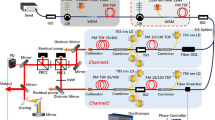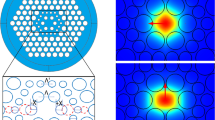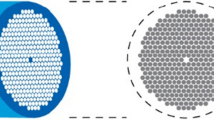Abstract
In Free Space Optical Communication (FSO), the optical signal from the laser source severely affects while travelling through free space atmospheric channel due to scattering, absorption and other effects of atmospheric turbulence conditions. This degrades the performance of FSO communication. In this article, we have generated the hollow beam from the laser output by the inverse axicon lens called inverted axicon beam. An artificial controlled turbulence chamber is created and the test signal has been transmitted through the turbulence conditions by employing various modulation schemes such as PAM, PWM, PPM, ASK, BPSK and QPSK separately. In all cases, we measured parameters phase jitter and Time jitter experimentally and the results are compared. Two types of wavelength laser sources such as red and green lasers are used for the analysis. In which, ASK provides a better withstand ability to jitter than other modulation techniques with atmospheric turbulence.


















Similar content being viewed by others
REFERENCES
Arul Teen, Y.P., Nathiyaa, T. Rajesh, K.B., and Karthick, S., Bessel Gaussian beam propagation through turbulence in free space optical communication, Opt. Mem. Neural Networks, 2018, vol. 27, no. 2, pp. 81–88. https://doi.org/10.3103/s1060992x18020029
Boucher, P., Hoyo, J.D., Billet, C., Pinel, O., Labroille, G., and Courvoisier, F., Generation of high conical angle Bessel–Gauss beams with reflective axicons, Appl. Opt., 2018, vol. 57, no. 23, p. 6725. https://doi.org/10.1364/ao.57.006725
Chaleshtory, Z.N., Gholami, A., Ghassemlooy, Z., and Sedghi, M., Experimental investigation of environment effects on the FSO link with turbulence, IEEE Photonics Technol. Lett., 2017, vol. 29, no. 17, pp. 1435–1438. https://doi.org/10.1109/lpt.2017.2723569
Dabiri, M.T. and Sadough, S.M.S., Generalized blind detection of OOK modulation for free-space optical communication, IEEE Commun. Lett., 2017, vol. 21, no. 10, pp. 2170–2173. https://doi.org/10.1109/lcomm.2017.2722472
Cox, M.A., Maqondo, L., Kara, R., Milione, G., Cheng, L., and Forbes, A., The resilience of Hermite- and Laguerre-Gaussian modes in turbulence, J. Lightwave Technol., 2019, vol. 37, no. 16, pp. 3911–3917. https://doi.org/10.1109/jlt.2019.2905630
Andrews, L., Philips, R.L., and Hopen, C.Y., Laser Beam Scintillation with Applications, SPIE Press, 2001.
Tsiftis, T.A., Sandlidis, H.G., Karagiannidis, G.K., and Sagias, N.C., Multihop free-space optical communications over strong turbulence channels, IEEE ICC Proc., 2006.
Gagliardi, R.M. and S. Karp, Optical Communications, Wiley, 1995.
Willebrand, H. and Ghuman, B.S., Free Space Optics: Enabling Optical Connectivity in Today’s Network, Sams Publishing, 2002.
Safari, M. and Uysal, M., Relay-assisted free-space optical communication, Proc. Asilomar Conf. Signals, Systems Computers, Monteray, CA, 2007.
Tsiftsis, T.A., Sandalidis, H.G., Karagiannidis, G.K., and Uysal, M., Optical wireless links with spatial diversity over strong atmospheric turbulence channels, IEEE Trans. Wireless Commun., 2009, vol. 8, no. 2.
Borah, D.K. and Voelz, D.G., Pointing error effects on free-space optical communication links in the presence of atmospheric turbulence, J. Lightwave Technol., 2009, vol. 27, no. 18, pp. 3965–3973.
Latsa Babu Pedireddi and Balaji Srinivasan, Characterization of atmospheric turbulence effects and their mitigation using wavelet-based signal processing, IEEE Trans. Commun., 2010, vol. 58, no. 6.
Yaoju, Z., Generation of thin and hollow beams by the axicon with a large open angle, J. Opt. Commun., 2008, vol. 281, pp. 508–514.
Angelis, M.D., Cacciapuoti, L., Pierattini, G., and Tino, G.M., J. Opt. Lasers Eng., 2003, vol. 39, pp. 283–291.
Saint-Denis, R.D., Cagniot, E., Leprince, P., Fromager, M., and Aitameur, K., Low cost adjustable axicon, J. Optoelectron. Adv. Mater., 2008, vol. 2, no. 11, pp. 693–696.
Arlt, J., Kuhn, R., and Dholakia, K., Spatial transformation of Laguerre-Gaussian laser modes, J. Mod. Opt., 2001, vol. 48, no. 5, pp. 783–787.
Mishra, S.R., Tiwari, S.K., Surjya, P.R., and Shrikant, C.M., Generation of hollow conic beams using a metal axicon mirror, J. Opt. Eng., 2007, vol. 46, no. 8, pp. 84002–84006.
Baumgart, l.J., Cizmar, T., Mazilu, M., Chan, C.V., Carruthers, A.E., Capron, B.A., McNeely, W., Wright, E.M., and Dholakia, K., Optical path clearing and enhanced transmission through colloidal suspensions, J. OSA Opt. Express, 2010, vol. 18, no. 16, pp. 17130–17140.
Author information
Authors and Affiliations
Corresponding authors
Ethics declarations
The authors declare that they have no conflicts of interest.
About this article
Cite this article
Arul Teen, Y.P., Lazer, N., Nathiyaa, T. et al. Investigation on Hollow Beam Propagation through Turbulence Conditions in Free Space Optical Communication. Opt. Mem. Neural Networks 28, 296–305 (2019). https://doi.org/10.3103/S1060992X19040027
Received:
Revised:
Accepted:
Published:
Issue Date:
DOI: https://doi.org/10.3103/S1060992X19040027




